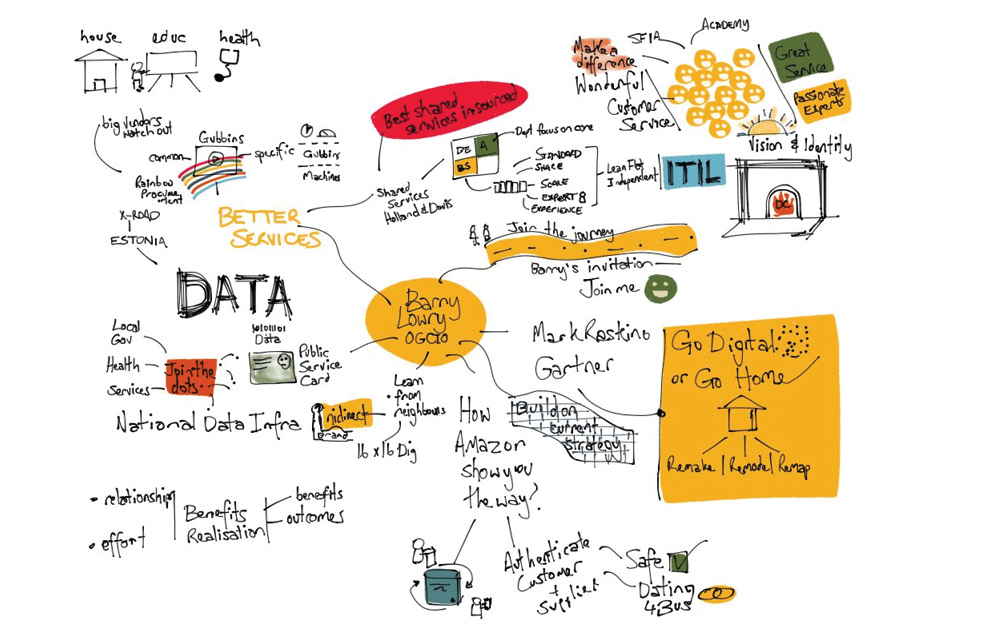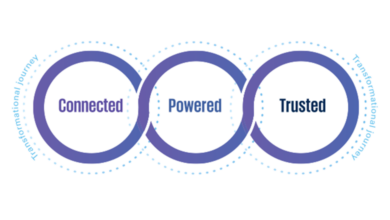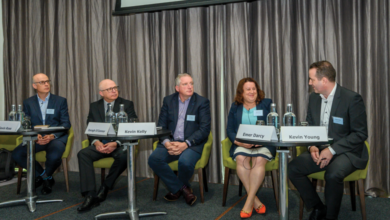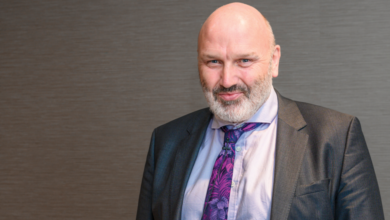Spearheading Ireland’s e-government strategy


In April this year, the Department of Public Expenditure and Reform appointed Barry Lowry as the Government’s Chief Information Officer. Ciarán Galway visits OGCIO headquarters to discuss his transition into the role.
“There are a number of aspects to the role. The first and primary aspect is taking forward the Public Service ICT Strategy. That was published by the Department in 2015 and it contains five pillars. These are: Build to Share, Digital First, Data as an Enabler, Improve Governance, and Increase Capability,” outlines Barry Lowry the former Director of IS Shared Services and Strategy in the Northern Ireland Civil Service.
The most recently appointed Government Chief Information Officer elaborates: “The first thing to mention is that I had read the document before I came here and I actually think it’s a very good strategy. I didn’t think it need changed, rewritten or anything else. The focus has been very much about trying to development a collegiate approach with the heads of IT and the CIOs in the departments to develop the five pillars of the strategy with a strong focus on outcome delivery.
“A secondary, but related aspect of the job is, on behalf of Ireland, taking forward the European eGovernment Action Plan 2016-2020. I would get quite involved with my colleagues in the other European Union countries and that’s extremely valuable because we get to compare notes about how well the various countries are progressing in terms of things like use of data, shared services, e-identification and so on.”
The vision, in a sentence, is that Ireland should be in the top three in Europe in terms of delivery of
e-government…
Vision
Emphasising the competitive qualities of the State, Lowry outlines: “The vision, in a sentence, is that Ireland should be in the top three in Europe in terms of delivery of e-government. When you look at the range of technology companies here, when you look at the capability of the people that we have, when you look at the size of the country and the agility we have, and actually, the very supportive ministers that we have, those ingredients should mean that Ireland scores significantly higher than the score that it currently has. It’s rated reasonably high at a European level, but it wouldn’t be rated as to one of the digital powerhouses. It should be.”
In an effort to pursue this vision, Lowry and the other departmental CIOs and Heads of IT worked to “develop an 18 step plan which covers the five pillars of the ICT strategy”. “This will help move us forward considerably in terms of what we’re trying to do. The idea being that this is something which helps the people to have a much better understanding of how government works,” he maintains.
He elaborates: “One example of that was when the budget came out, on the same day we launched a website (www.whereyourmoneygoes.gov.ie) to show how exactly it was being subdivided across health, education and so on. It’s had a lot of very positive reviews. I think it exemplifies what the Government’s trying to achieve through the e-government minister; transparent, informing and consultative government.”
Initial impressions
Lowry observes: “My initial impression was that the challenges were vast but also very exciting. That’s why I came here in the first place. One of the main challenges is getting tangible plans to share more across government, whether that be technology, data or skills. Having said that, it was very encouraging to see that the key catalysts for change, the Civil Service Renewal Plan and the concept of the ‘One Vision’, were already in place.”
“This hasn’t come along because of me; this has preceded me. There is a general recognition and understanding that the departments can achieve so much more by working together and I co-chaired my first meeting a couple of weeks ago about taking forward the Public Services Card (PSC). All the departments were represented and some of the ideas that were coming up about future use of the card, because the Government has set itself an objective of trying to maximise use of that card, were really exciting and have huge possibilities.”
Lowry adds: “I think it’s very important to emphasise that I haven’t just arrived and all of a sudden we’re working better together across Government. This was a process that was started before I came. Hopefully I’m helping to facilitate it further, but actually getting that to happen is a challenge.”
Using Estonia as an example of rapid delivery in terms of digital government, Lowry emphasises: “Of course Estonia had no legacy. In Government here we’ve invested very vast sums of money having great systems for paying benefits, for tax collection and so on, we’re not going to retire those overnight and build something completely different, and so the idea of organic change is very important. While legacy is, in some respects a barrier to moving really quickly, it provides a great deal of assurance that this is a Government and a Civil Service that does business very well.”

Credit: Gar Mac Críosta
https://twitter.com/aspiringarc/status/730352476642226176.
Amazon-style portal
Explaining the reasoning behind the terminology of an ‘Amazon-style’ digital services gateway, the Government CIO clarifies: “Very much like Amazon itself, it may well be that a citizen only wants to go on and consume information or perform a certain type of transaction where they don’t need to leave their name and address details. That’s absolutely fine, this is very much an optional service. But what we would like is for the citizen to leave their details and allow us to use them because that will help us deliver a more user-orientated experience. I’ve used the example before, if we know that people have children at Leaving Cert age, we could start to push college content towards them. We’re trying to be more helpful.”
“The portal is undergoing a public consultation exercise at the minute. We’re bringing in various representative bodies of the public and we’re testing it with them. We’re working through to get ideas as to, do they understand what it’s there for? Do they see the value in it? Are there things we could do better.”
He adds: “We want to take on board the feedback and we’ll deliver another version of that with ministerial agreement. Hopefully it’ll be accepted in the spirit that it’s given because we don’t want people to criticise it, we want people to give constructive advice. We want it to be a useful tool and one that people will see benefit in.”
Stressing the substantial importance attached to the development of such a portal, Lowry illustrates: “I’m very conscious, because Dublin is very much now a European city. A large proportion of the people who live and work here aren’t indigenous and so for them to easily understand how to do business with Government and understand how services work is very important. It’s obviously very important for our own indigenous people as well. This is the plan. That we start to create a much more accessible government and an easier government to work with, and obviously digital is at the heart of that.”
Trust
In the sphere of e-government, trust represents a crucial challenge to e-government, but also a considerable opportunity. “I think the way to build up the trust [with citizens] is through transparency. What we must be able to clearly do is let them see how we’re using their data. If you take Estonia for example, you can log on to the Estonian citizen portal and you can find out who has actually been looking at your data. Now clearly we need to build this, but we’ll let it build organically.
“We not only want to be an exemplar in digital government, we want to be an exemplar in adherence to the best principles of data protection. It’s an issue for government to manage that tension between doing more with the data, but doing more in a way that the citizen feels is appropriate and is happy with. Once that trust builds, once the understanding grows, then you’re creating an environment where you will be allowed to do more with the data and that’s very important going forward. Especially in terms of the European Digital Single Market.”
Lowry reiterated Minister for Public Expenditure and Reform Paschal Donohoe’s response to any suggestion that the Public Services Cardwas a National Identity Card by another name. “First of all, it’s not mandatory to have one and secondly, it’s not mandatory to carry it, so it’s not a national ID card.”
He elaborates: “The reason why we like the idea of expanding the use of the Public Services Card, for me, is that there is a lot of added value services that can be built up through the card. The thing underlining all this is choice. If I don’t want to carry the Public Services Card and if I don’t want to use it, other than for reason that I applied for it, then that’s my choice. However, if I want to use it and try to maximise the benefit of it and indeed get one for that reason, then that’s a good use of the card as well. A perfect example of that is the travel card. The fact that we are now producing Public Services Cards that are also travel cards is a positive and convenient thing.”
Enhanced levels of
e-government
Responding to the suggestion that this policy alone may not be in enough to ensure that Ireland progresses to the levels of e-government exhibited in Estonia or Denmark, Lowry is unambiguous. “No it won’t because they specifically passed legislation to accelerate this. Now we are looking at legislation around making better use of our data and obviously that will go through the proper due diligence process, but they already have that in place so it will take us a while to catch up. For example, in Denmark it’s mandatory to use e-identification unless there is justified means why you can’t. In Estonia it’s mandatory to have both the card and the e-identifier.”
“While we don’t intend to go that far in Ireland, we will need legislation to underpin our conceptual National Data Infrastructure, which will set out the framework for sharing data more effectively across agencies to provide better citizen services and better evidence to inform policy making”.
He asserts: “The best European models are built on trust between the citizen and the Government. That’s the thing that really needs to underpin this good relationship. If you accept that the Government is using your data for your best purposes, and you can also check that they absolutely are, then I think most people would be reasonably happy with government sharing data within government. It’s very much about using the citizen’s data in a way that helps us provide a better overall service.”
Government services cloud catalogue
Speaking on his predecessor’s decision to scrap the Government Services Cloud Catalogue, Lowry clarifies: “What I’ve agreed with the Office of Government Procurement on this, and they’ve been very helpful, is that we’ll have a conversation about how we use procurement to take forward the Public Service ICT Strategy.”
He accepts: “The whole idea of a government cloud was very good, however, perhaps the implementation of it wasn’t quite right for that time. And of course, we all know what the situation was economically, even two or three years ago. So, what I would say is that it was right for Bill [McCluggage] to come up with the idea, it was right for Michael [McGrath] to scrap it, but it’s still right for me to look at a different way of doing it. I think that sometime over the next several months, OGCIO will enter into a conversation with the industry and be more consultative with how we might implement this and hopefully get something that works for the buyers in Government, but also works for the industry as well.”
Government-industry collaboration
Summarising his attitude towards the enhancement of e-government in Ireland, Lowry contends: “I think that Government and industry collaboration is absolutely critical. I think it’s the role of a government to ensure that these things are done well and done right, but that doesn’t mean to say that government needs to do every single one of them itself. Partnerships are absolutely key to moving this forward quickly and the really reassuring message that I’ve got, because I’ve met a lot of players in the industry now, is that these guys are all passionate about Ireland being seen as a European and even world leader. They’re as passionate as I am and I’ve lots of commitments from senior figures in the industry that they will work with the Government and they’ll really try and help us achieve the delivery of the Public Service ICT Strategy and achieve it well.”
He concludes: “That’s really encouraging because we’ve got an industry commitment and certainly an industry capability. We’ve definitely got a commitment from the civil service and we’ve got a ministerial commitment as well. So those three things together should help us move forward.”
Profile: Barry Lowry
Barry Lowry spent almost 35 years in the Northern Ireland Civil Service (NICS) on work ranging from the programming of mainframe computers to operating as a team leader in the design of client server systems. For the five years prior to his appointment, Lowry was the director who oversaw the establishment of ICT shared services in NICS. He also operated as the Head of Profession for ICT. In 2011 he was voted the Northern Ireland IT Professional of the Year by his associates.
Outside of work, Lowry enjoys reading, especially biographies, and listening to music, particularly that of his son’s band. Lowry and his wife are currently working their way through the assortment of restaurants in Malahide and between this he is kept busy with trips to the gym.






